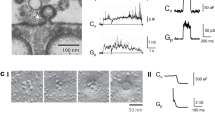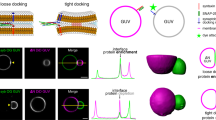Abstract
THE fusion of membranes is a key to the control of lysosomal function. Membrane fusion is involved in both the intra and extracellular digestion of extracellular material (fusion between endocytotic vacuoles or between plasma membrane and enzyme-bearing vesicles) as well as in the formation of autophagic vacuoles. Primary lysosomes fuse readily with newly formed endocytotic vacuoles1,2; they seem to be able to fuse with heterolysosomes3 but never directly with mitochondria or nuclei. Because of scanty information the apparent specificity in the fusion pattern of primary lysosomes cannot be explained in terms of relationships between membrane composition and function. Dingle4 has proposed, in analogy to the coalescence of closed shells of fluid, or the ‘breaking’ of an emulsion by agglomeration of droplets to larger ones, that the fusion of cell membranes of high surface tension will be thermodynamically favoured. According to this suggestion lysosomes should be regarded as high surface tension vesicles.
This is a preview of subscription content, access via your institution
Access options
Subscribe to this journal
Receive 51 print issues and online access
$199.00 per year
only $3.90 per issue
Buy this article
- Purchase on SpringerLink
- Instant access to full article PDF
Prices may be subject to local taxes which are calculated during checkout
Similar content being viewed by others
References
Hirsch, J. G., and Cohn, Z. A., J. exp. Med., 112, 1005 (1960).
Hirsch, J. G., J. exp. Med., 116, 827 (1962).
Maunsbach, A. B., J. ultrastruct. Res., 16, 197 (1966).
Dingle, J. T., Br. med. Bull., 24, 141 (1968).
Howell, J. I., and Lucy, J. A., FEBS Lett., 4, 147 (1969).
Schneeberger, E. E., and Harris, H., J. Cell Sci., 1, 401 (1966).
Apostolov, K., and Post, G., Microbios., 6, 247 (1972).
Lucy, J. A., Ahkong, Q. F., Cramp, F. C., Fisher, O., and Howell, J. I., Biochem. J., 124, 46p (1971).
Lucy, J. A., in Lysosomes in Biology and Pathology (edit. by Dingle, J. T., and Fell, H. B.), 2, 313 (North-Holland, Amsterdam, 1973).
Smith, A. D., and Winkler, H., Biochem. J., 108, 867 (1968).
Fowler, S., and De Duve, C., J. biol. Chem., 244, 471 (1969).
Schramm, M., Selinger, Z., Salomon, Y., Eytan, E., and Batzri, S., Nature new Biol., 240, 203 (1973).
Goldman, R., and Rottenberg, H., FEBS Lett., 33, 238 (1973).
Goldman, R., FEBS Lett., 33, 208 (1973).
Gomori, G., Microscopic Histochemistry: Principles and Practice (University of Chicago Press, Chicago, 1952).
Spurr, A. R., J. ultrastruct. Res., 26, 31 (1969).
Author information
Authors and Affiliations
Rights and permissions
About this article
Cite this article
RAZ, A., GOLDMAN, R. Spontaneous Fusion of Rat Liver Lysosomes in vitro. Nature 247, 206–208 (1974). https://doi.org/10.1038/247206a0
Received:
Revised:
Issue date:
DOI: https://doi.org/10.1038/247206a0



